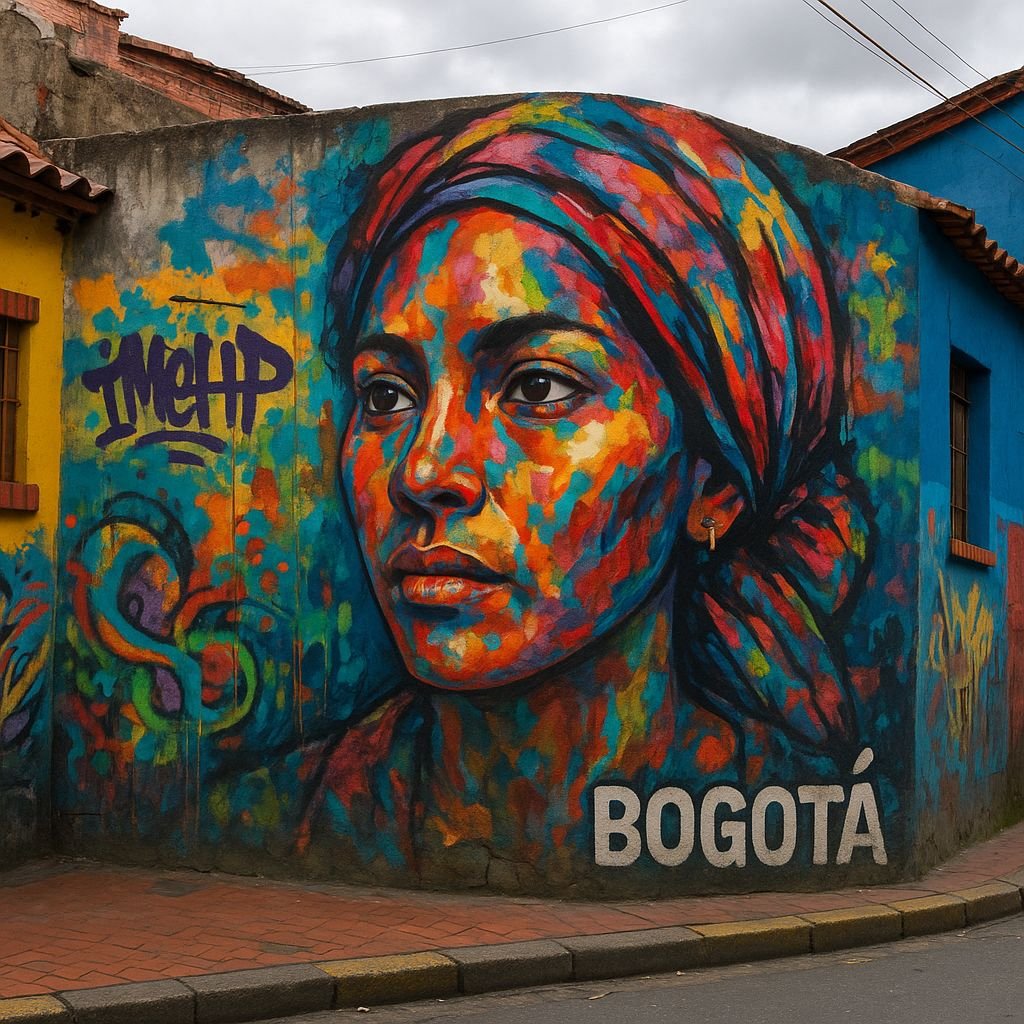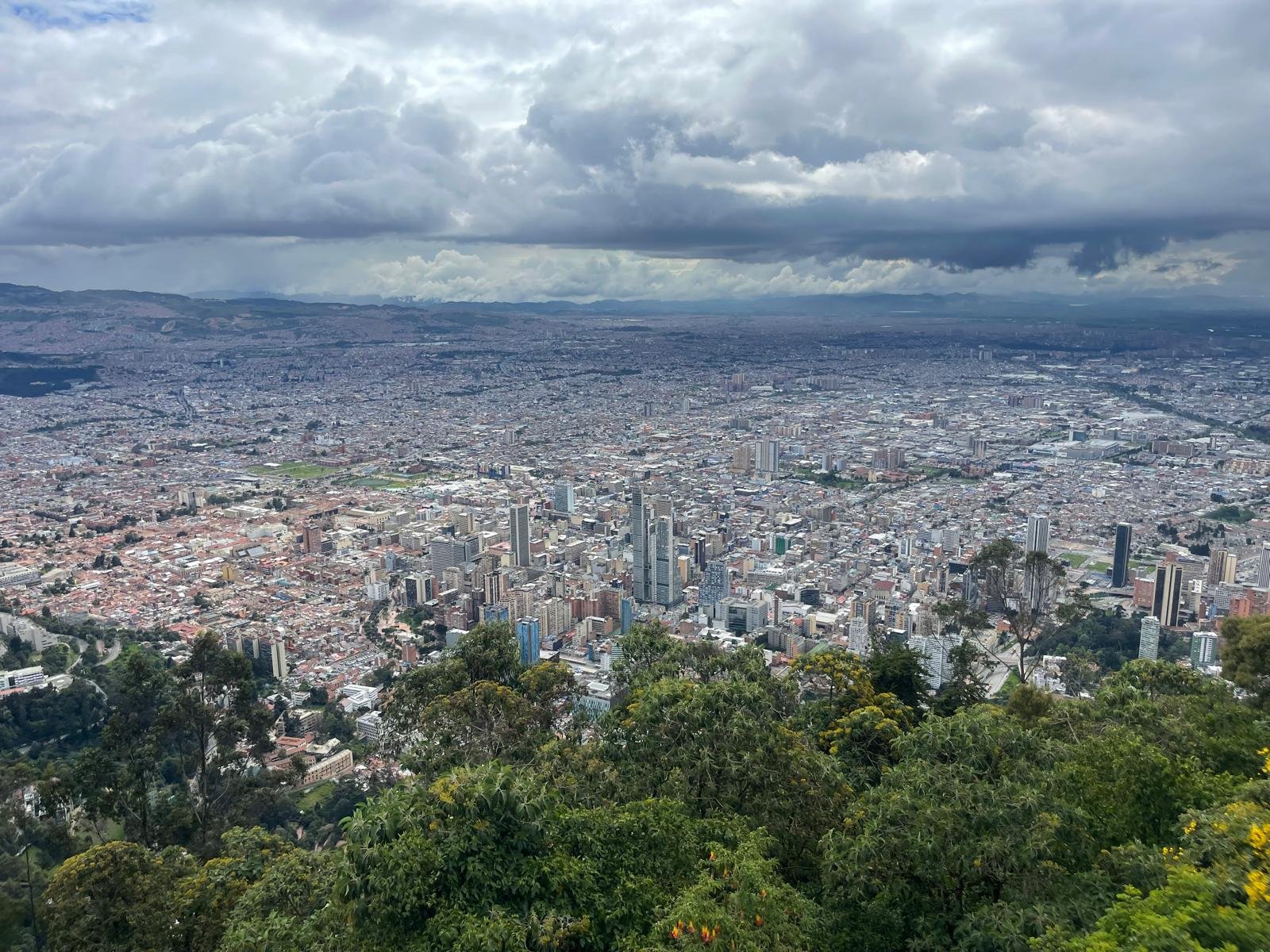Bogotá is a city that surprises you at every turn. Perched high in the Andes, Colombia’s capital blends colonial charm with a modern, cosmopolitan vibe. Its vibrant street art, world-class museums, and diverse culinary scene make it a cultural powerhouse. Whether you’re exploring the historic neighborhoods, savoring traditional dishes or taking in panoramic views, Bogotá offers a rich mixture of experiences. In this post, we’ll delve into what makes Bogotá a must-visit destination and how to make the most of your trip.

Exploring Bogotá’s Historic Heart: La Candelaria, Plaza Bolívar & the City Center
Day 1 From Museo Nacional to Monserrate Views
Start your day by browsing through Colombia’s rich history at the Museo Nacional, the oldest and largest museum in the country. With a vast collection spanning art, archaeology, ethnography, and history, it’s easy to spend 2 to 3 hours exploring the exhibits. Afterward, treat yourself to a scoop of ice cream from Crepes & Waffles To Go, conveniently located just down the street.
From there, enjoy a walk past the Plaza de Toros de Santamaría, an iconic red-brick bullring built in the 1930s, which stands as a cultural landmark and occasional event space. Continue your stroll through Independencia Park and the adjacent Bicentenario Park, green spaces that offer a refreshing pause amid the urban bustle and connect the modern city to the historical district of La Candelaria.
Once you’ve taken in some fresh air, you can make your way to the entrance of Serro de Monserrate a prominent mountain rising 3,152 meters (10,341 feet) above sea level. While it’s technically walkable, the route can pass through some less secure areas, so it’s recommended to take a taxi or Uber. At the base, you have two options to reach the summit: hike the 1,605 steps (free, but physically demanding), or ride the San Juan de Monserrate funicular or aerial cable car for about US$8 round trip—a scenic and relaxing way to ascend. Monserrate is open all weekdays until 10pm except sundays which loses at 6pm.
Monserrate dates back to pre-Columbian times when the indigenous Muisca people, who inhabited the Bogotá savanna, considered the mountain sacred. They observed that during the June solstice, the sun rises directly behind Monserrate when viewed from Bolívar Square, leading them to associate the mountain with their solar deity, Sué. Following the Spanish conquest, Catholic influences replaced indigenous religious practices.
At the top, you’ll be rewarded with the best panoramic views of Bogotá from the Saint Jeroni viewpoint. You can also visit the Monserrate Museum, the Monastery of Santa María de Monserrate, or the Santa Cueva, a sacred site where the Virgin of Monserrate is believed to have appeared. Don’t forget to bring a warm jacket—the temperature drops significantly at that altitude. There are two restaurants at the summit. Casa San Isidro, a French restaurant, offers a seasonal menu in a romantic, colonial-style setting. Casa Santa Clara, housed in a charming French-imported home from the 1800s, serves a variety of Latin American and Colombian dishes with sweeping views from its elegant dining room. One of my favorite spots is the Bistro Café, located on the ground floor of Casa Santa Clara. It’s the perfect place to unwind with a beer or coffee while listening to the wind and gazing through the trees.
Day 2 – Dive Into Bogotá’s Cultural Core
Start your day early at the San Alejo Flea Market, a weekend treasure trove where you’ll find everything from vintage cameras and vinyl records to antique jewelry and handcrafted curios. Then, stroll down Carrera 7, famously known as El Septimazo—a bustling pedestrian avenue filled with street performers, vendors, and a true sense of Bogotá’s urban energy.
Your first cultural stop is the renowned Museo del Oro (Gold Museum), home to over 55,000 pre-Columbian gold artifacts. The museum offers a fascinating glimpse into the spiritual beliefs, artistry, and craftsmanship of Colombia’s ancient indigenous cultures. It’s one of the most impressive collections of its kind in the world.
Continue your walk to Plaza Bolívar, the political and historical heart of Bogotá. This grand square is surrounded by significant buildings, including the National Capitol, Colombia’s seat of Congress, and the Catedral Primada, a majestic 18th-century cathedral with neoclassical architecture that dominates the plaza.
Take a short break at Arte y Pasión Café, just steps away, where expertly crafted coffee and a warm ambiance make it a perfect pause in your day. Afterward, head to the nearby Pasaje Rivas, one of Bogotá’s oldest artisan arcades. Here, you can browse stalls filled with handmade crafts, leather goods, traditional toys, and souvenirs in a charming, historic setting.
From Pasaje Rivas, walk over to the elegant Teatro Colón, Colombia’s national theater and a neoclassical gem inaugurated in 1892. If you’re lucky, you might catch a rehearsal or book a guided tour of its richly decorated interior, featuring frescoes, ornate balconies, and grand chandeliers.
Next, make your way to the nearby Museo Botero, housed in a beautifully restored colonial mansion. This museum showcases the work of Fernando Botero, Colombia’s most famous artist, known for his voluminous and exaggerated figures. Alongside his paintings and sculptures, you’ll also find works by international masters like Picasso, Dalí, and Monet—part of Botero’s personal collection gifted to the country.
End your walk at Chorro de Quevedo, considered the birthplace of Bogotá. This cobbled plaza oozes bohemian charm and is surrounded by colorful colonial buildings, cafes, and street performers. It’s a great spot to soak up the atmosphere and reflect on the city’s layered history.
Bonus Tip: Bogotá is globally recognized for its vibrant street art. From Chorro de Quevedo, join a free graffiti walking tour (tip-based), which dives into the stories, politics, and artistry behind the murals that color the city. Tours depart daily at 10:00 AM and 2:00 PM and can be booked in advance through Gran Colombia Tours.
Explore Usaquen on a Sunday
Usaquén is a charming and historic neighborhood in the north of Bogotá where you can spend an entire day exploring. Once a separate colonial town, it now enchants visitors with its cobblestone streets, Spanish colonial architecture, diverse culinary scene, and vibrant cultural energy. On Sundays, the neighborhood comes alive with a popular flea market offering everything from handcrafted home décor and unique fashion pieces to local original artwork, handmade jewelry, vintage goods and unique artisan crafts.
Wander through cozy cafés perfect for getting lost in a book, or indulge in one of the many gourmet restaurants that line the streets. Usaquén effortlessly blends old-world charm with modern comforts, making it a favorite destination for both locals and travelers in search of a laid-back yet culturally rich experience.
You can start your stroll through Calle 116Bis and Carrera 7, right next to Hacienda Santa Bárbara Shopping Center, a beautifully restored colonial estate turned into a boutique mall. From there, begin wandering the quaint streets of Usaquén in a leisurely order, allowing you to soak in the charm of its preserved colonial architecture, colorful facades, and hidden courtyards.
Make your way toward Parque Usaquén, the heart of the neighborhood, where locals gather and markets buzz with energy. Along the way, you’ll find a wide range of excellent dining options—from traditional Colombian cuisine to international flavors—all set within a historic and picturesque setting. Exploring Usaquén feels like stepping into a small colonial village within the modern capital, offering an experience that is both relaxing and culturally enriching.
Day Trip to Tequendama Falls or Lake Guatavita
Both places are approximately one hour via taxi or Uber from the city but I find that renting a motorcycle is a more adventurous way to experience the world. There are several places you can Rent a motorcycle for they day at affordable prices like Hola Alquila tu Moto or 4rent.
Tequendama Falls Where Myth Meets Nature
A ride to Tequendama Falls (Salto del Tequendama) is a quick escape into nature. The scenic route winds through Andean hills with beautiful views of the savanna and the countryside. Once there, enjoy the impressive 132-meter waterfall and the eerie charm of the old Hotel del Salto. It’s a short, rewarding ride that offers a mix of adventure, history, and stunning landscapes—all within reach of the city.
Tequendama Falls is one of Colombia’s most iconic natural landmarks, with a rich blend of myth, history, and environmental significance. The 132-meter waterfall has long been a sacred site in Muisca mythology, where it’s said the gods created the gorge to drain a great flood and save humanity.
In the early 19th century, the German naturalist Alexander von Humboldt visited the falls during his famous expedition through South America. He was captivated by the dramatic drop and surrounding biodiversity, documenting the area in his studies and helping to introduce Colombia’s natural wonders to the scientific world.
Once a popular weekend retreat during Bogotá’s Belle Époque, the area saw the construction of the Hotel del Salto in the 1920s, a grand mansion perched on the cliff’s edge, which later became abandoned and shrouded in urban legends. Today, it’s been restored and transformed into a museum dedicated to local history and ecological awareness.
Lake Guatavita de Sacret Lagoon of El Dorado
a day trip to Lake Guatavita offers a peaceful escape and a journey deep into Colombia’s mythical past. Surrounded by misty forests and rolling green hills, this circular lagoon sits at over 3,000 meters (9,800 feet) above sea level and is steeped in legend, nature, and mystery.
Lake Guatavita is best known as the inspiration behind the legend of El Dorado. According to Muisca indigenous tradition, the newly crowned chief would cover himself in gold dust and sail to the center of the lake in a ceremonial raft, offering gold and precious treasures to the gods by tossing them into the water. These stories fueled centuries of treasure hunts by conquistadors and explorers, though much of the gold was never found—adding to the lake’s mythical aura.
The site is now a protected natural reserve. A guided hike (roughly 1.5 hours round-trip) takes you around the rim of the crater-shaped lake, offering panoramic views, native flora, and insights into the Muisca culture and the lake’s ecological significance. Though swimming or boating is no longer allowed to protect the environment, the views alone are well worth the visit.
On the way back, you can stop at the charming town of Guatavita, a picturesque whitewashed village rebuilt in the 1960s after the original town was flooded by the Tominé Reservoir. Here, you’ll find artisan shops, cafés, and a relaxed vibe perfect for lunch or a coffee break before returning to Bogotá.
Whether you’re drawn by history, nature, or the search for mythical gold, Lake Guatavita offers a magical and meaningful day trip from the capital.
A Visit to Bogotá’s Green Oasis: The José Celestino Mutis Botanical Garden
If you’re looking for a quiet, refreshing escape from the city buzz, a visit to the José Celestino Mutis Botanical Garden is a must. Located in the northwest of Bogotá, this expansive 20-hectare park is the largest botanical garden in Colombia and serves as a living museum of the country’s astonishing biodiversity. Entry is very affordable—just a few dollars—and offers hours of peaceful exploration, making it one of the city’s best-value attractions.
The garden showcases Colombia’s diverse ecosystems, including tropical rainforests, páramos (high mountain moorlands), deserts, and Andean forests. Highlights include the tall glass-domed Tropicarium, home to exotic Amazonian species, and beautifully maintained thematic gardens filled with medicinal plants, orchids, roses, palms, and native trees. There’s also a butterfly house, educational exhibits, and seasonal flower shows. It’s an ideal place for nature lovers, photographers, and families alike.
The garden is named after José Celestino Mutis, an 18th-century Spanish botanist and astronomer who led the Royal Botanical Expedition of New Granada, one of the most important scientific missions in Latin America. Mutis dedicated decades to studying Colombia’s flora, cataloging over 6,600 plant species, many of which were previously unknown to science. His work laid the foundation for botanical studies in the region.
Mutis had a notable intellectual exchange with Alexander von Humboldt, the famous German explorer who visited New Granada in the early 1800s. Humboldt deeply admired Mutis’s scientific rigor and botanical illustrations, and the two men corresponded about the rich natural heritage of the Colombian Andes. Their shared passion helped bring international attention to South America’s biodiversity.
Whether you’re wandering through orchids, relaxing in the shade of a native tree, or learning about Colombia’s ecological richness, the José Celestino Mutis Botanical Garden offers a peaceful, educational, and inspiring experience—right in the heart of Bogotá.
Special Mentions to Round Out Your Bogotá Experience
Colombia is the second most biodiverse country in the world, home to over 400 different types of native fruits—many of which are unique to specific regions and rarely found outside the country.
To get a taste of this diversity, head to Paloquemao Market, located in the Paloquemao neighborhood. It’s one of Bogotá’s most iconic local markets and a sensory experience like no other. While it doesn’t have all 400 fruits, you can sample a wide variety—like lulo, guanábana, uchuva, and mangostino—alongside fresh flowers, local produce, and street food. It’s a perfect way to connect with everyday Colombian culture.
For a more upscale vibe, explore Zona T, a fashionable district known for its boutiques, lively bars, and restaurants. A top pick here is Central Cevichería, a popular spot offering flavorful seafood with a fusion of Peruvian and Colombian influences in a fun, vibrant setting.
Just a short distance away is Parque de la 93, a green, modern space surrounded by trendy cafés, restaurants, and lounges. Whether you’re out for a relaxed brunch or evening drinks, it’s a favorite hangout among locals and visitors alike—perfect for winding down your Bogotá adventure.
Where to Stay
Bogotá offers a diverse selection of hotels and hostels to suit every budget, with many accommodations featuring generous breakfast buffets. Whether you’re looking for a stylish modern stay or something close to the historic center, the city has you covered.
One of my top picks is the EK Hotel, located in the vibrant Chapinero neighborhood Just a few blocks from Zona T. The hotel features sleek, contemporary architecture and spacious rooms. Within the same courtyard, you’ll find excellent restaurants such as Crepes & Waffles, Cacio e Pepe, Black Bear, Osaki, and Gamberro, making dining convenient and varied. EK Hotel also offers complimentary bicycles for guests—perfect for a morning ride through nearby Virrey Park or a Sunday cycle along Bogotá’s Ciclovía, when major streets are closed to cars and open to pedestrians and cyclists.
If you prefer to stay closer to La Candelaria and the city’s historic sites, consider the Four Points by Sheraton Tequendama, recently renovated and ideally located. Other great options include hotels near 93 Park or in Zona T, both upscale areas known for their lively atmosphere, great restaurants, and easy access to Bogotá’s top attractions.
Final Thoughts: Why Bogotá Belongs on Your Travel Bucket List
From historic plazas and world-class museums to vibrant street art, lush gardens, and unforgettable day trips, Bogotá offers a rich blend of culture, nature, and adventure. Whether you’re savoring exotic fruits at Paloquemao Market, enjoying high-altitude views from Monserrate, or wandering the charming streets of Usaquén, the capital of Colombia surprises and delights at every turn.
Have you been to Bogotá—or is it now on your travel list? What part of this city would you explore first? Let us know in the comments!

